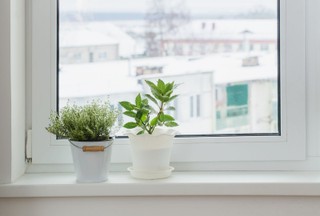What you need to know to grow herbs indoors during winter

Herbs are great plants to grow indoors during the winter months whether you are a novice or an expert gardener. They are relatively easy natured so they don’t require constant care and fussing over. They simply need to be put in a spot where they get adequate sunlight and watered as needed. Not only can you reap the benefits of fresh herbs, but they also add a touch of greenery to your space, as well as an enticing aroma.
What herbs thrive indoors during winter?
Many herbs are grown as annual plants outdoors, completing their entire life cycle in a single growing season. Bringing them indoors extends their life by removing them from the cold temperatures and shorter day lengths in the fall that trigger them to produce seed in an effort to reproduce.
If you are looking to grow your own herbs indoors during the winter, start with one of the following as they’re known to thrive inside as houseplants.
- Bay laurel grows as an evergreen tree or shrub, with its leaves used in seasoning many slow-cooked dishes like casseroles and stews. Shrubs are hardy and super easy to care for. Growing them in containers outdoors restricts their overall size, keeping them smaller and more manageable.
- Chervil has a mild aniseed flavor and grows well indoors because of its tendency to bolt when summertime temperatures climb outside. A member of the parsley family, chervil is popular in French cuisine and is known for complimenting egg dishes.
- Chives are a milder member of the onion family, imparting a subtle flavor in dishes. They are common in omelets, summer salads, and potato salad.
- Oregano accentuates many Mediterranean and Mexican dishes and is becoming a popular specimen in indoor herb gardens. As an interesting side note, the subtly flavored oregano flowers are a great topping for salads.
- Parsley is a multi-functional, classical Italian herb that has proven itself worthy as both a culinary herb and for its practical purposes. This herb used to be relegated to the corner of plates but now takes center stage for its flavor. Curly leaf parsley is less flavorful and is primarily used as decoration. Italian or flat-leaf parsley is known for its robust flavor.
- Rosemary grows as a highly aromatic evergreen shrub. Its strong flavoring is used sparingly in lamb, pork, and veal dishes. Choose ordinary green rosemary over the more decorative variegated types; they are less hardy. Rosemary plants don’t need much water, making them difficult to grow; most people over water their plants.
- Thyme bears heady aromatic leaves on a low-growing evergreen plant. Its flavor depends on the variety chosen and is commonly used in meat dishes, soups, and stews.

Why start an indoor herb garden during winter?
There are two primary reasons for starting an indoor herb garden that will grow throughout the winter.
- The first is the desire to have access to fresh, homegrown herbs all winter long. Without a doubt, homegrown herbs are more flavorful than fresh or dried ones bought from the store.
- The second reason is for keeping tender perennials alive through the winter. In certain hardiness growing zones, outdoor winter temperatures drop below a point where certain herbs can survive. Moving them indoors (this may entail simply bringing containers inside, or digging plants up and transplanting them into containers) protects them from the harsh conditions, keeping them alive for another growing season.

The enthusiast's guide to herbs
We’re proud to present our new e-book, The Enthusiast’s Guide to Herbs! Learn everything you need to know about growing and caring for herbs indoors, including in-depth info cards for the 35 most commonly grown herbs.
Click the link below to find out more!
How to grow herbs indoors during winter
Growing herbs indoors is straightforward if you have the correct supplies and the right growing conditions.
Supplies needed
To grow herbs indoors in containers you’ll need the plants you want to grow, the material you want to grow them in, and the containers that will hold everything.
Plants
You can opt to move established plants inside, or you can start new plants from seed or propagate them from cuttings. All options have distinct advantages and drawbacks. Seeds are cheaper to buy but take more time and commitment; cuttings have less cost associated but you need access to established plants.
Growing Media
Choosing a good quality growing media for containers is important: it acts as a reservoir for moisture and nutrients, it provides “empty” space for air around the roots, and it supports the plants by anchoring the roots. Coconut coir and commercial potting mixes are the two most common growing substrates used in containers.
Coconut coir is composed of the brown and white fibers found between the shell and the outer coating of a coconut seed. Commercial potting soil mixes are a blend of ingredients, typically comprised of peat moss or coconut coir, pine bark, and either perlite or vermiculite. Both types of growing media are lightweight and hold moisture well, making them ideal for container plants.

Containers
There are three primary aspects to take into consideration when deciding on containers for your plants: container size, the materials they are made from, and if they have good drainage holes.
In terms of size, it’s critical to choose containers that are deep enough for the plant’s mature root structure and wide enough to keep from tipping over from the weight of the plant(s). Err on the side of caution and choose containers slightly larger than the plants may need.
For growing herbs indoors, opt for containers that are plastic, fiberglass, or terra cotta.
- Plastic or fiberglass pots are lightweight and come in a variety of sizes, colors, and shapes. They are inexpensive, helping to keep out of pocket expenses down.
- Terra cotta pots are breakable and heavy, but durable and long-lasting. Air movement through the pots and growing media help regulate soil moisture levels, keeping the soil from becoming waterlogged.
Look for pots with holes in the bottom to allow excess water to drain; overwatering is a critical problem as it depletes oxygen in the soil, harming the root systems.
Growing conditions
Providing the right amount of sunlight and the correct ambient temperature encourages the strong, healthy growth of your herb plants and the best tasting foliage.

Temperature
Penn State Extension recommends keeping herb plants in rooms having an air temperature between 65-70℉ during the day, and 55-60℉ at night. Many can survive nighttime temperatures below this but the drastic variation will cause plant stress and decreased growth.
Avoid putting containers in a spot where they are exposed to cold drafts from a window or door or register vents that blow hot air in the winter. This drastic change in temperature can cause your herbs stress, affecting their flavor.
Sunlight Exposure
Outside, herb plants typically love full-sun locations because of their quick growth. They need plenty of sunlight for photosynthesis, a process within the plant that creates glucose for food.[1] Indoors they survive on a minimum of 6 hours of sunlight a day but prefer spots that receive 10-12 hours of sun.
When choosing a location for plants stick to a sunny windowsill of a south or west-facing window for the best sun exposure. South-facing windows provide the most sunlight, with light streaming through them all day. Windows facing westwardly are a good alternative; they receive a long period of direct sunlight but often miss the hottest, most intense part of the day.
Periodically rotate containers for even growth.
If there isn’t enough light for herb plants indoors your plants will grow tall and spindly, and their flavor won’t be as robust, Consider trying a different window that may have better sun exposure or purchase a simple grow light with incandescent or fluorescent bulbs to supplement the natural light. For more information, head over and read my guide to indoor lighting!
Watering
There’s a fine balance between giving plants enough water without over watering them. Many herbs don’t like to have soggy “feet” so you should be careful to only water as needed.
For most herbs, water when the top 1 inch of potting soil is dry. Water until excess starts to drain out the bottom of the container.
Harvesting
Herbs respond well to frequent harvesting; regularly removing foliage from plants triggers new growth, encouraging full, bushy plants.
Harvesting is straightforward.
- Harvest in the morning if possible.
- Using clean, sharp scissors or even your fingernails, snip or cut off stems right above the node where a pair of leaves originates. Do not leave a stub of the stem on the plant.
- Periodically pinch off branch tips to encourage your plant to grow outward instead of upward for a fuller shape.
- If plants are overgrown, you can do a more severe harvest. Starting from the top of the plant begin harvesting stems, making sure to remove no more than ⅔ of the plant at any given time.
- For the best flavor, harvest before plants flower. If they do flower, remove flowers and wait to harvest for a couple of days.
Conclusion
Growing herbs indoors in winter is a great way to have a year-round supply of fresh herbs, as well as safely overwintering tender perennials that may not survive harsh outdoor winter temperatures. With the right supplies and the necessary growing conditions, you’ll quickly be on your way to a new adventure in indoor gardening!

Join our email club—get printable info cards free!
Sign up to receive our newsletter and get access to 10 printable plant info cards from our e-book for free. Also receive:
- $4 discount code for our Guide to Herbs e-book
- Semi-weekly plant inspiration & bite-size tips and tricks
Smithsonian Science Education Center STEMvisions Blog. (2017, April 12). Retrieved November 12, 2019, from https://ssec.si.edu/stemvisions-blog/what-photosynthesis ↩︎
